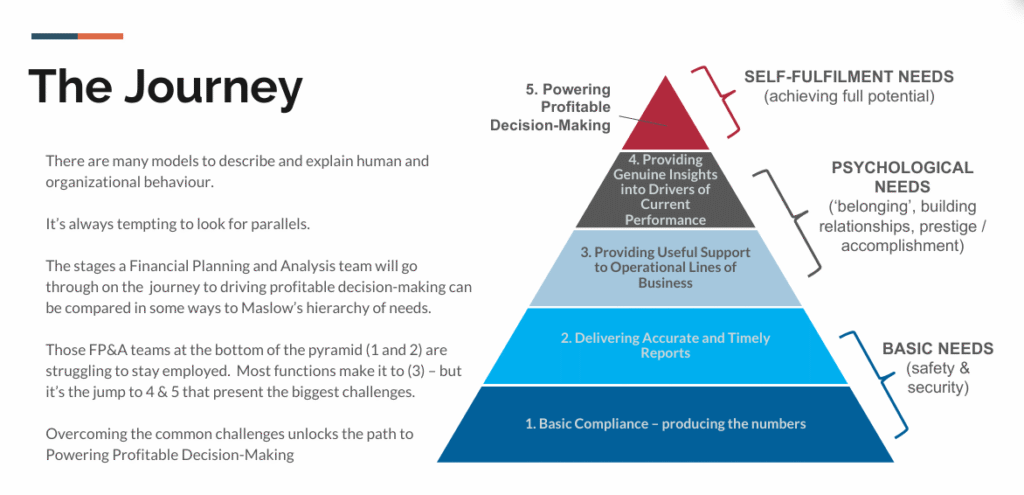Expert Insights: Part 1 – Get Set, Go!
 By Declan Rodger | 6 May 2025
By Declan Rodger | 6 May 2025
Here at Spitfire Analytics our team of experienced finance professionals offer help and advice to help our clients across diverse sectors to Power Profitable Decision-Making.
Over the coming weeks, beginning with today’s article, Operations Director Adam Whittick will be sharing some of his knowledge and expert analysis from his experiences.
What’s in store?
In the first post in the series, Adam will discuss getting started on the path to profitable decision-making and some of the barriers that he’s observed in teams he’s been part of and clients he has helped.
We’ll then examine different approaches to implementing systems to move finance functions forward.
In article two we’ll observe that the same software can be applied to deliver the same solution – but that different approaches to delivering the solution can have very different results.
In the third article in the series, Adam will look at what happens when the finance function can put itself at the centre of the business. How some really exciting things start to happen when other parts of the business are able to get their hands dirty with robust, accurate financial insights.
About Adam:
Adam started his career working for a world-renowned luxury car firm and led their implementation of IBM® TM1.
He has since worked with IBM® TM1 across various industries, in businesses large and small, from the private and public sector. Adam enjoys finding efficiencies in company processes and activities, both through implementing completely new systems and working on existing systems to increase efficiency and accuracy.
Part 1: Get Set, Go!
‘The Journey’ came from looking back at projects that Spitfire had undertaken and from the team’s experience as finance professionals. It’s something of a journey of continuous improvement and new discoveries as completing each project throws up new insights that in themselves create new questions.
“The concept of it being a journey is right – it just rings true” says Adam. “If I was to think about where people are and I look at the bottom of the triangle, it feels like it could be this long” he says whilst looking at the diagram (see below) – holding his arms wide to demonstrate.

“I think all of us at Spitfire have at some stage in our careers been at the bottom of the mountain, stuck doing cyclical work and wondering what it’s like at the top”.
Adam talks of the challenges that management teams face – needing insights that help them make decisions in the here and now as well as making plans for the long-term. That can feel like a long-way further up when a finance team is running hard just to get just the monthly finance activities completed.
Adam first became aware of “The Path” – or the journey – as the financial crisis hit.
“As the recession hit, suddenly at the same time as the normal day-job of producing reports, checking the system, doing journals – just finance activities – we now desperately needed to plan for how we dealt with this unfolding disaster.”
The changing nature of the developing crisis created new pressures.
“Sales are down – we might have to cut cost, we might have to lay people off. What are the impact of making cuts in which areas? Are there other ways of doing it?”
“We were already challenged trying to get the basic stuff done – and in the world of spreadsheets trying to get answers to new questions in a reasonable time, it’s not easy. It’s a big pressure on people as well, which over time takes its toll”
“We couldn’t just throw more people at it – we’d just keep getting in each other’s way and adding to the chaos. We needed to make a step toward working smarter and improving the way we did the cyclical day-job work to free up resource that would enable us to provide meaningful answers to the questions being asked.”
This was a clear case of knowing that there was a direction that the finance function needed to set off in before the end goal was clear. Certainly in this environment the final destination was less important than making a start at this point.
“The foundations are incredibly important – getting the basic numbers together quickly and accurately. Getting these together quickly, being able to update actuals vs plan in a timely manner, creates time to understand what the numbers are telling you.”
Time has moved on but if anything, the need for answers and the ability to be able to figure out how to cope in changing times is even more important. As change in consumer behaviour is compounded by dynamic global economic conditions, complexity increases at an exponential rate.
Recognising that barriers exist to providing accurate and timely answers is often the stimulus to getting started. Lots of people working in multiple spreadsheets can create a drag on productivity.
“We’ll often see teams where there are people sat next to each other working on the same dataset, spending similar amounts of time converting it into useful answers.” Says Adam, highlighting a duplication of effort. “It’s also the case that we all have our own quirks in how we work with spreadsheets – meaning no two spreadsheets work the same way. Data gets decentralised and errors come in.”
Duplication of effort, error resolution, data lifting and shifting – all create activities within the process that don’t add value.
“The first step on the path is removing these non-value-adding activities. If you can replace those with a system that can be populated with millions of rows of data in seconds, have it do it the same way every month and present it at aggregate level, detail level, however you need – then those niggly spreadsheet tasks are removed. This releases people for all kinds of higher-value activities further up the chain”.
Having everyone working with a ‘single version of the truth’ – the same set of actuals – faster and without the slog. That’s a great first step. The next step is often stimulated by the time it frees up:
“Suddenly, there’s all of the data in one place, in one plan – where you can see where its coming from, who did it – and it’s come together a lot easier. There’s now time to look at it and talk about it, question it maybe or ask why…. Immediately there’s momentum toward new insights.”
Posted 2 months ago in Articles. Filed in Consultancy, Design & Implementation, Finance & Professional Services.





